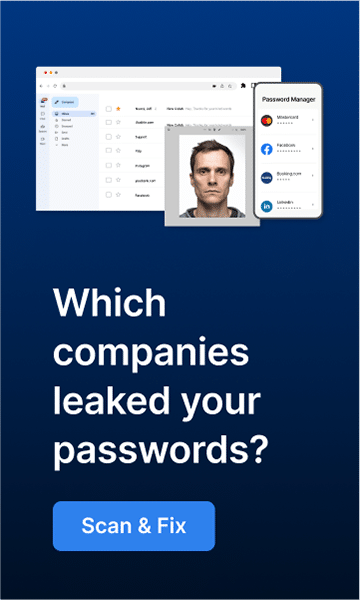Data leaks occur when internal errors expose information to unauthorized parties. Lack of training, outdated systems, and poor data security are all common causes. A data leak could lead to harmful consequences such as identity theft, data breaches, or ransomware installation.
Many well-known companies, including American Airlines, Maryland’s health department, and the Metropolitan Transportation Authority of New York, have previously suffered data leaks. In 2021, due to a Microsoft software misconfigured setting, a data leak exposed at least 38 million records, including employee information, vaccination reports, contact tracing, and testing appointments related to Covid-19.
How do data leaks and data breaches differ?
Both leaks and breaches involve unauthorized data exposure, but whether they are leaks or breaches depends on the cause.
There are many ways in which criminals can attempt to crack a network. Criminals can use data from a data leak to launch a large-scale data breach. When information is exposed from an internal source, it is considered a data leak. In contrast, a data breach is when an external attack breaches a system from the outside. The difference between a data leak and a breach is that a leak is usually an accident, while a breach usually occurs due to malicious intent.
Data leaks are all criminals need to produce a massive data breach. There is no doubt that leaks pose a serious threat to organizations, just as data breaches do. However, data leaks can be prevented by understanding what causes them.
Causes of data leaks
1. Setting up software incorrectly
There is a possibility that misconfigured or outdated software settings could expose sensitive customer information. In addition, there could be the threat of cyberattacks if the leaking software is popular. Protecting data requires careful configuration of all infrastructure by organizations.
2. Social engineering
Cybercriminals often leak data due to a tactic or social engineering trick.
Social engineering aims to obtain sensitive credentials from victims by manipulating their psychological state. Social engineering attacks are most commonly carried out verbally or electronically through phishing.
Verbally attacks
Threat actors impersonating IT technicians might use verbal phishing to target employees. As a result of a critical internal issue, the threat actor may request login credentials.
The performance will seem very believable to an uneducated victim if accompanied by provocations that reflect a sense of urgency on the company’s part. Using the leak of personal data, hackers could breach an IT perimeter and begin a cyberattack sequence after relinquishing personal information.
Phishing attacks
Electronic phishing attacks are more widespread and can reach a more significant number of victims much faster. In social engineering, email phishing is the most common method.
Despite appearing legitimate, phishing emails contain infected links that appear to be from reputable sources. Phishing emails trick users into clicking on links that install malware or load a dummy website designed to steal information.
A growing number of sophisticated phishing emails are becoming harder to detect, especially when they exploit recipients’ anxieties.
3. The use of recycled passwords
Since users tend to use the same password across various logins, a single compromised password can compromise several digital solutions.
4. Sensitive devices being stolen
When company devices are lost or stolen, sensitive information can be accessed, resulting in security breaches or identity theft.
Cybercriminals can gain remote access to a company’s private network by persuading an IT administrator to divulge this information.
As a result, the compromised laptop is the attack vector exposing data leaks that connect the compromised employee to the company’s IT administrator.
5. Security vulnerabilities
Cybersecurity issues can easily arise from software vulnerabilities. Security threats can be created by criminals using outdated software or zero-day exploits. In this way, criminals bypass the initial stages of the attack lifecycle, propelling them straight into the privilege escalation phase – the last step before a data breach occurs.
It is possible to exploit these vulnerabilities to gain unauthorized access to the network, install malware on the computer, compromise social media accounts, and even steal credit card information.

Data Leak Prevention Strategies for 2023
1. Implement browser protection software.
Users can monitor their identities while browsing online with the Guardio Browser extension. Among Guardio’s features, the company’s security team develops in-house features to detect phishing, and tech support scams, among other threats. Your privacy can be compromised when a data breach occurs at a service you use. With Guardio, you can immediately take action to prevent identity theft by seeing past leaks and getting real-time alerts.
2. Third-party risk assessment.
The vendors you work with may not take cybersecurity as seriously as you do. The security posture of all vendors needs to be continually evaluated to ensure that critical security vulnerabilities aren’t causing data leaks.
3. Ensure that all network access is monitored.
It is easier to identify suspicious activity if more corporate network traffic is monitored. It is common for cybercriminals to conduct reconnaissance campaigns before launching a cyber attack to identify certain defenses that will have to be circumvented.
Organizations can prevent reconnaissance campaigns by identifying and strengthening security vulnerabilities.
4. Determine which data is sensitive
By carefully uncovering and classifying the data into its respective categories, businesses can establish optimal protection against potential leaks for each type. With precise identification of sensitive information comes to a greater trust in their security system to ensure that all confidential information is always safe.
5. Ensure that all endpoints are secure.
Endpoints communicate with a business network either through end users or autonomously. Mobile devices, desktop computers, and Internet of Things (IoT) appliances are included.
Almost every organization now employs a remote working model, dispersing endpoints (sometimes internationally). Endpoint security needs to extend to the cloud.
VPNs and firewalls offer a basic level of endpoint security, but more is needed. To bypass these security defences, criminals often introduce malware into an ecosystem.
Cyberattackers use trickery to trick organizations, especially with email phishing and social engineering attacks.
6. All data must be encrypted.
If the data is encrypted, cybercriminals may have difficulty exploiting leaks. Public-key encryption and symmetric-key encryption are the two main types of data encryption.
Although encrypted data may seem impossible to amateur hackers, a cyber attacker with the right skills can decrypt it without a decryption key. Therefore, these methods should be used alongside data encryption as a data leak prevention strategy.
7. Permissions should be evaluated.
Companies should evaluate all permissions to prevent unauthorized individuals from gaining access.
Companies should categorize critical data into different sensitivity levels to control access to other data pools. Highly sensitive data should only be accessible to trusted staff with essential requirements.
As a result of this procedure, malicious insiders that facilitate the exfiltration of sensitive data may also be identified.
8. Keep track of all vendors’ security postures.
Vendors cannot confirm that their cybersecurity efforts have been successful without a monitoring solution.
Data breach susceptibility is evaluated with security scoring. Organizations have instant visibility into the security rating of their entire vendor network using these monitoring solutions.
In closing
As data breaches continue to be one of the biggest threats to modern organizations, businesses must implement a robust data leak prevention strategy. Key elements of such a strategy include implementing a browser protection software like Guardio, third-party risk assessment, monitoring network access, identifying sensitive data, securing endpoints, encrypting all data, evaluating permissions, and tracking vendor security postures. By combining these strategies and implementing cybersecurity best practices, organizations can protect themselves against the many risks posed by potential data leaks.


